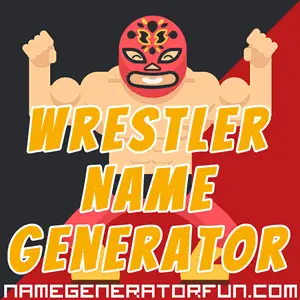Name Generator > Funny Names > Wrestler Names
Wrestler Name Generator
Don your spandex, flex your muscles and cue up your entrance music – it's time for you to stride into the ring and embrace your inner powerhouse with our wrestler name generator!

Wrestler Names
Do you like spandex? Are you a total badass but at the same time a bit of a drama queen? Then this page is for you! Credit for much of this generator goes to our friend Oliver Hanbidge-Smith, a big muscular man's man who loves to play wrestling games, and who once managed to create WWE Smackdown wrestling characters that looked like rather alarming My Little Ponies. If you enjoyed this generator you might also want to check out our tough guy generator, also created with the help of Oliver.
A Brief History of Pro Wrestling
The story of wrestling goes all the way back to Prehistoric times, with the first pictorial representations of the sport being cave paintings in the Bayankhongor province of Mongolia that date to 7000 BC. Over the centuries, many types of folk wrestling have evolved, especially in the UK, with the rise of the Cornish and Devon styles, and the Cumberland and Westmoreland styles hailing from the more northerly counties, as well as the collar-and-elbow wrestling that developed in Ireland. Other types of wrestling evolved across the world, from Naban wrestling in Burma to Sumo in Japan and Shuai Jiao in China, but the most recognised styles of wrestling currently used by professional wrestlers and Olympic competitors are Greco-Roman and Freestyle wrestling.
As a sport, wrestling started to properly capture the imagination of the public in the mid to late nineteenth century, and was soon being regulated in the form of formal competitions. What is now looked upon as 'pro wrestling' began in the USA in the wake of the American Civil War, as athletes with amateur wrestling experience began to compete at travelling carnivals, with carnies working as their promoters and bookers. The wrestling shows that evolved were just as much entertainment as they were genuine sport, livening up simple 'strongman' acts and featuring lurid stage names or nicknames that were designed to be attention-grabbing.
These competitions would often be fixed or 'engineered' by the organisers simply because traditional wrestling between two well-matched opponents was not always an exciting prospect for the audience, and could often end up going on for hours. The first wrestling superstars arose in this period – Martin "Farmer" Burns, and his pupil Frank Gotch – and for many decades, wrestling was just as popular in America as baseball. However, the more theatrical side of pro wrestling became more elaborate and its popularity started to wane in the 1910s, as the audience started to cotton on to its tricks and no longer believed in it as a genuine competitive sport.
In response to this, three professional wrestlers – Ed Lewis, Toots Mondt and Billy Sandow – decided to join forces and promote themselves together, and also started to use a regular team of wrestlers to create a specifically packaged show, meaning the theatrical feuds between various competitors could be turned into long-running sagas. This is where the specific wrestling-related roles of the 'Face' (good guy) and 'Heel' began to properly evolve, and the financial success that Lewis, Mondt and Sandow achieved netted them the nickname of the 'Gold Dust Trio', and as well as laying the foundation of the success of pro wrestling that was to come. From there onwards, pro wrestling leaned further into its choreographed nature, especially once the 1950s arrived and televised wrestling matches meant an even greater audience could be reached.
One of the first mainstream wrestling superstars of this period was George Raymond Wagner, known as 'Gorgeous George', who netted major attention thanks to his deliberately outrageous stage persona. His approach differed from many wrestlers of the time who'd simply imitate ethnic stereotypes (like menacing Nazis or evil Arabs) – George instead created a much more individualistic and narcissistic character who was the prototype for many wrestling superstars to come, and also pioneered the use of having his own entrance music to the ring.
Gorgeous George's success spawned a host of competitors, as many wrestlers joined with dreams of becoming superstars rather than simply achieving athletic success. The characters became broader and even more theatrical, and the stage names became ever more lurid and memorable, especially thanks to the rise of the Capitol Wrestling Corporation, which eventually transformed into the now globally-known World Wrestling Entertainment Inc (WWE).
Pro Wrestling's stylised and increasingly choreographed nature gradually became referred to as 'kayfabe', referring to the sense of performance and treating the rivalries and relationships between the wrestlers as real, whether inside or outside the ring. While wrestling's choreographed nature was an open secret for many decades, it was not publically acknowledged until 1989, when WWE owner Vince McMahon testified before the New York State Senate, and admitted that wrestling was not a competitive sport.
This happened in the middle of what's generally referred to as the 'boom' for Pro Wrestling, going from the 1980s into the early 1990s, during which wrestlers like Hulk Hogan rose to prominence. However, the public reveal of Pro Wrestling's true nature barely put a dent in its popularity, and the cartoon-like characters (including wrestlers like the Undertaker and Stone Cold Steve Austin) continued their increasingly elaborate and melodramatic feuds and rivalries. Since then, WWE has dominated the world of Pro Wrestling (with their main competitor, WCW, finally admitting defeat in 2001), and the heavily choreographed world of acrobatic fights, theatrical fights and lurid wrestler names looks set to continue for many decades to come.
Wrestler designed by Freepik. Licensed under CC BY 3.0.
